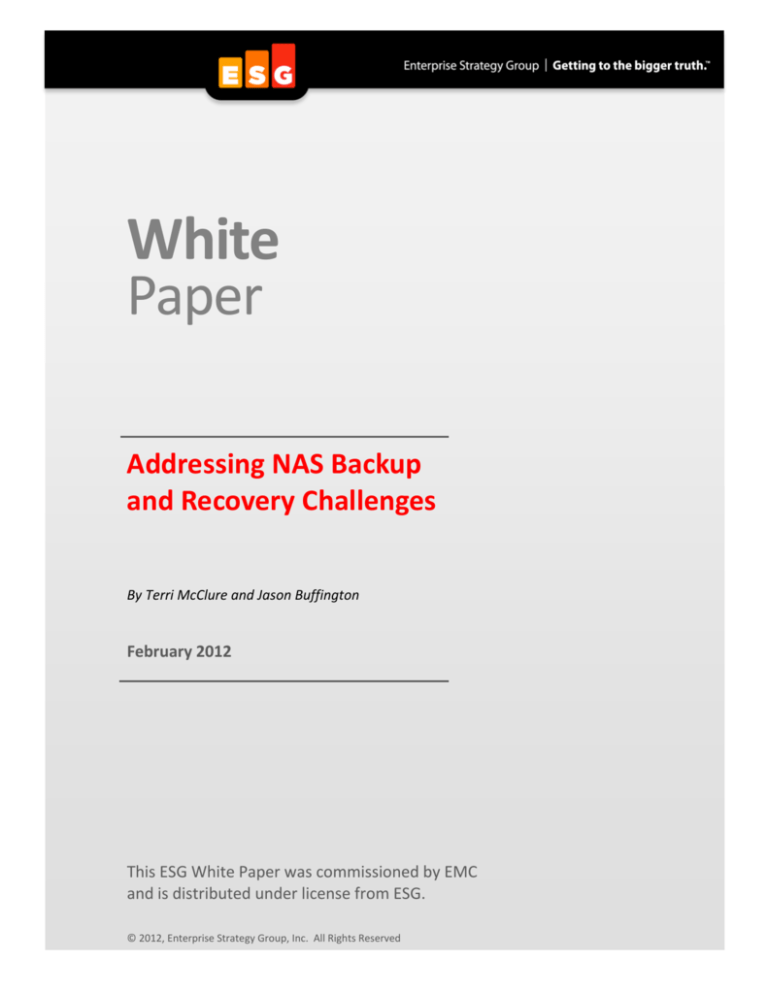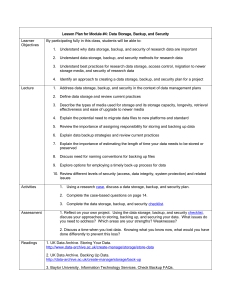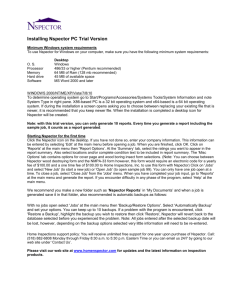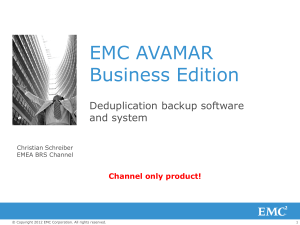
White
Paper
Addressing NAS Backup
and Recovery Challenges
By Terri McClure and Jason Buffington
February 2012
This ESG White Paper was commissioned by EMC
and is distributed under license from ESG.
© 2012, Enterprise Strategy Group, Inc. All Rights Reserved
White Paper: Addressing NAS Backup and Recovery Challenges
2
Contents
Introduction .................................................................................................................................................. 3
Data Protection Challenges for Unstructured Data...................................................................................... 3
NAS and File Storage Continue to Grow ....................................................................................................... 4
Continued Adoption of NAS for Enterprise File Serving ........................................................................................... 5
Backup and Recovery in NAS Environments............................................................................................................. 5
Backup and Recovery Alternatives ........................................................................................................................... 5
EMC Avamar’s Innovative Solution for NAS Backup and Recovery.............................................................. 7
Avamar Backup and Recovery .................................................................................................................................. 7
How Avamar Works .................................................................................................................................................. 7
Avamar Improves NAS Backup and Recovery .......................................................................................................... 7
No Compromises ...................................................................................................................................................... 8
The Bigger Truth ........................................................................................................................................... 9
All trademark names are property of their respective companies. Information contained in this publication has been obtained by sources The
Enterprise Strategy Group (ESG) considers to be reliable but is not warranted by ESG. This publication may contain opinions of ESG, which are
subject to change from time to time. This publication is copyrighted by The Enterprise Strategy Group, Inc. Any reproduction or redistribution of
this publication, in whole or in part, whether in hard-copy format, electronically, or otherwise to persons not authorized to receive it, without the
express consent of the Enterprise Strategy Group, Inc., is in violation of U.S. copyright law and will be subject to an action for civil damages and, if
applicable, criminal prosecution. Should you have any questions, please contact ESG Client Relations at (508) 482-0188.
© 2012 Enterprise Strategy Group, Inc. All Rights Reserved.
White Paper: Addressing NAS Backup and Recovery Challenges
3
Introduction
Meeting service level agreements (SLAs) for full network data management protocol (NDMP) backup and recovery
is often a challenge. Performing a full NDMP backup is more likely to exceed the window of time allocated to
backup—potentially disrupting application availability and end-user productivity. The process also consumes a
significant amount of network and system resources.
EMC utilizes integrated global, client-side data deduplication and replication to back up network attached storage
(NAS) systems in hours, not days. This creates tremendous efficiency over more traditional approaches to NAS
protection, saving time in backup and recovery operations and minimizing the use of network bandwidth and
storage capacity.
Data Protection Challenges for Unstructured Data
The majority of capacity under management in the commercial sector will be born as file-based digital content.
This data encompasses a wide range of types, including Microsoft Office files, PDFs, scanned images, CAD/CAM,
source code, check images, and x-rays as well as Internet-era rich content such as video, audio, blogs, and wikis.
Unstructured data and file shares are growing exponentially. ESG research indicates that growth in this area will
exceed that of other data types—estimating 226 exabytes of archived file data by 2015, dwarfing database- and email-based archive data (see Figure 1). 1
Figure 1. Projected Archive Data Growth by Type
Total Archived Capacity, by Content Type, Worldwide, 2010-2015 (Petabytes)
350,000
300,000
250,000
200,000
150,000
100,000
50,000
0
2010
2011
2012
2013
2014
2015
File
25,127
39,237
59,600
92,536
147,885
226,716
Database
4,065
6,179
9,140
13,824
21,532
32,188
E-mail
4,025
6,575
10,411
16,796
27,817
44,091
Source: Enterprise Strategy Group, 2012.
File data proliferation has created challenges for management and backup/recovery. As such, it is not surprising
that improving backup and recovery ranked as the number one 2012 IT priority reported by respondents to a
recent ESG research survey 2. Complete, reliable, high-performance backup and recovery is a persistent problem for
1
2
Source: ESG Research Report, Digital Archiving: End-User Survey & Market Forecast 2010-2015, July 2010.
Source: ESG Research Report, 2012 IT Spending Intentions Survey, January 2012.
© 2012 Enterprise Strategy Group, Inc. All Rights Reserved.
White Paper: Addressing NAS Backup and Recovery Challenges
4
IT organizations that is often exacerbated by data growth. In fact, the top data protection challenges are tied to
data growth, including costs, reducing backup times, and keeping pace with the capacity of data to protect.. 3
NAS environments contribute to growth in storage capacity as they have a high degree of redundancy within their
file shares. Backup solutions that don’t filter and eliminate duplicate data risk consuming a lot of storage and
impacting network links, and still not completing backup processes within the allotted timeframes. As such, it is not
surprising that ESG research has found significant levels of deduplication technology adoption, especially among
enterprise organizations (see Figure 2) 4.
Figure 2. Usage of Data Deduplication Technology
Is your organization currently using any data deduplication solutions?
(Percent of respondents)
Midmarket (100 to 999 employees, N=141)
45%
Total (N=323)
41%
40%
35%
Enterprise (1,000 or more employees, N=182)
37%
31%
30%
25%
22%
26%
24% 23%
20%
20%
17%
15%
15% 16%
15%
10%
4% 4% 4%
5%
0%
Yes
No, but we plan to
within 12 months
No, but we plan to
within 24 months
No, and we have no
plans to
Don't know
Source: Enterprise Strategy Group, 2012.
Another issue plaguing many NAS systems is that they typically reside in remote locations. Local backups are
difficult as these branches are often not staffed with backup administrators. Centralized backup is impractical due
to the potential bandwidth impact of daily backup capacity traversing the network.
NAS and File Storage Continue to Grow
Storage and management of file-based data gave rise to technology optimized for those functions. A NAS device is
purpose-built to store files and perform file serving tasks. NAS systems are typically dedicated, high-performance
data storage systems running embedded proprietary operating systems optimized for disk IO. NAS device hard drive
space accessed via an Ethernet connection can be used as primary storage by any or all host devices on that
network.
Many organizations use NAS systems because they are easy to install and deploy, are affordable, and are reliable,
ensuring support requests are kept to a minimum. Other factors driving adoption include ease of capacity
expansion and ease of administration, especially when serving files to heterogeneous clients.
3
4
Source: ESG Research Report, The Modernization of Data Protection, report to be published.
Ibid
© 2012 Enterprise Strategy Group, Inc. All Rights Reserved.
White Paper: Addressing NAS Backup and Recovery Challenges
5
Continued Adoption of NAS for Enterprise File Serving
Massive file data growth is driving increased adoption of NAS. ESG research continues to see widespread use of NAS
platforms across both midmarket (86%) and enterprise (84%) organizations. 5 While NAS platforms are commonly
used as primary storage, they also frequently serve as target repositories for disk-based backup. Indeed, recently
conducted ESG research 6 on the topic of data protection revealed that – on average – nearly one-quarter of the
total amount of on-site disk-based backup capacity is provided by NAS-based systems and devices (see Figure 3).
Figure 3. NAS Capacity Is Frequently Used for Disk-based Backup
What percentage of your immediate organization’s total volume of on-site backup
data is stored on each of the following types of disk-based storage systems? How do
you expect that to change over the next 24 months? (Mean, N=217)
Today
35%
30%
In the next 24 months
32%
26%
23%
25%
24%
20%
14% 15%
15%
11% 10%
15%
13%
10%
8%
10%
5%
0%
Internal (server) Direct-attached Network-attached Fibre Channel iSCSI storage area VTL (virtual tape
storage
storage (DAS)
storage (NAS)
storage area
network (SAN)
library)
device
device
network (SAN)
device
device
Source: Enterprise Strategy Group, 2012.
Backup and Recovery in NAS Environments
Traditional file server backup methodologies utilize a software agent that runs on each production server. The
backup client agent facilitates data capture and transfer, and communicates with the central backup engine. Since a
NAS device usually runs a proprietary operating system and is dedicated to serving files, it doesn’t typically
accommodate backup software components such as a software agent usually needed to facilitate backup and
recovery.
Backup and Recovery Alternatives
Proxy Backup
One of the simplest ways to back up NAS environments is to maintain a proxy backup system on the
network where the backup agent is installed. Each NAS volume requiring backup can then be mounted via
common interface file system (CIFS) or network file system (NFS) sharing protocols to the server hosting the
5
6
Source: ESG Research Report, Scale-out Storage Market Trends, December 2010.
Ibid
© 2012 Enterprise Strategy Group, Inc. All Rights Reserved.
White Paper: Addressing NAS Backup and Recovery Challenges
6
backup agent. This approach is less efficient due to excessive use of network bandwidth to move data
between systems, which has the potential to introduce performance degradation for backup operations.
NAS System-specific (Built-in) Data Protection
Many NAS platforms may offer built-in data protection features to facilitate backup and recovery. For
example, a snapshot provides local or remote block-level point-in-time (PIT) copies. However, the number
of snapshots may be limited (up to 250, for example), which can introduce retention issues. In addition,
many snap-based protection mechanisms encounter challenges when restoring individual files and/or
exposing their file recovery options in a useful way outside of the NAS management tool itself.
In addition to PIT copies, many NAS platforms offer replication to enable scenarios that include local or
remote and synchronous or asynchronous mirroring. These native tools may require added license fees and
will likely be limited to operating on homogenous storage systems. Snapshot copies typically capture only
changed blocks between each PIT copy, minimizing the number of blocks captured, transferred, and stored.
With greater frequency of snaps, recovery point objectives (RPOs) can be improved. One of the hidden
costs of this approach is that the NAS device may pre-allocate disk space for snapshots (often estimated to
be 20% of total volume) on more expensive primary storage.
NDMP Backup
The network data management protocol (NDMP) is an industry-standard programming interface that
provides best practice backup and recovery for NAS systems. An NDMP-approach enables a backup server
to communicate directly with a NAS appliance and to transmit data to the specified backup storage device.
NDMP eliminates the need for backup vendors to write device-specific code for NAS devices to facilitate
backup (e.g., backup agent software). Instead, any authorized third-party backup application running on its
own backup or media server on the network has access to a set of commands to read from or write to NAS
via NDMP for backup and restore purposes, respectively. The advantage of this approach is that it
eliminates the load from production servers and can keep backup traffic off of the production LAN since the
NAS device sends its individual files and metadata directly to the backup platform and its media.
There are some tradeoffs associated with this technique, including additional costs for NDMP licenses from
the backup software vendor. Most traditional backup solutions leveraging NDMP require a weekly full
“Level 0” backup and daily incremental “Level 1” backups. Completing full backups within the prescribed
window is more often a challenge given the massive amount of data on NAS systems today. Full backups
that run too long can impact end-user productivity and application availability. Difficulty in completing the
weekly full backup will impede NAS consolidation goals, preventing IT organizations from maximizing their
NAS investments.
Traditionally, scans of large file systems added hours to the incremental backup process because the entire
file system (many millions of files and directories) had to be traversed to check for changes—which can be
new, modified, or deleted files. Any change to a large file required backup of the entire file, not just of the
changes. Redundant copies of files, particularly common in unstructured data sets such as home
directories, will also impact backup time and storage consumption on both the production platforms and
the backup servers.
Recovery processes are also affected by these large file set challenges. Recovering from a backup failure is a
much slower process since checkpointing is not supported. Backup software must read sequentially
through the backup image to locate the requested information. Recovery could require multiple steps to
restore a directory, individual file, or set of files unless direct access restore (DAR) is supported by the
backup vendor.
© 2012 Enterprise Strategy Group, Inc. All Rights Reserved.
White Paper: Addressing NAS Backup and Recovery Challenges
7
EMC Avamar’s Innovative Solution for NAS Backup and Recovery
Avamar Backup and Recovery
EMC Avamar is backup and recovery software with integrated data deduplication technology. As part of its backup
workflow, it pre-identifies and ignores redundant sub-file data segments at the client system level, dramatically
reducing the amount of backup data sent over the network. By only sending deduplicated and unique changes,
Avamar provides fast backups even across slow or congested links. It also reduces the storage consumed by the
backup platforms’ storage via deduplication across sites and servers globally—making disk-to-disk backup more
feasible than a disk-to-tape approach both from a technology perspective and also in terms of its economic cost.
Avamar also enables the creation of offsite data copies for disaster recovery purposes via site-to-site deduplicated
replication over a WAN connection. Data can be encrypted in-flight as it traverses the network, as well as at-rest on
the backup media, for added security and privacy. Avamar backup data on disk can also be exported to physical
tape media.
The solution is ideal for fast and secure backup and recovery of not only NAS environments, but also of virtualized
VMware environments, desktop and laptop systems, and remote offices.
How Avamar Works
Deduplication at the client drives Avamar’s advantages and is the reason it is able to solve key enterprise data
protection challenges. Enterprise data is highly redundant, with identical files and sub-file data segments stored
within systems and across systems company-wide. Traditional backup software magnifies the problem by storing
redundant data over and over again. Avamar’s solution is to view primary data in sub-file chunks called data
segments. The software generates and assigns each data segment a unique ID based on its content, which is then
used to compare it with other data segments that have already been backed up. Only new, unique data segments
are transferred during a backup operation, ensuring that only a single instance of each segment is stored in a
central location. Avamar eliminates redundant backup data at the client—before that data is sent across the
network. It also deduplicates across sites and servers, which is why it is considered “global.” As a result, Avamar
provides daily full backups and dramatically reduces backup times, the impact on the backup network, and the
required back-end disk storage for cost-effective retention on disk and fast, single-step recovery.
Avamar Improves NAS Backup and Recovery
To address many of the aforementioned challenges of protecting NAS-resident data, EMC offers Avamar NDMP
Accelerator. A single, dedicated Avamar NDMP Accelerator Node uses NDMP and acts as a pass-through conduit
from one or more NAS devices to the Avamar server. Deduplication at the Avamar NDMP Accelerator Node creates
efficiency by reducing demand on network and system resources and improving performance significantly over
traditional NDMP full backups. Avamar supports leading NAS solutions including the EMC VNX Family, EMC Celerra,
and NetApp NAS systems.
The result? With Avamar, the weekly full backup becomes a thing of the past. The initial Avamar NDMP backup of
the NAS environment is a full “Level 0” backup. Thereafter, Avamar only requests daily incremental “Level 1”
backups, which take significantly less time to complete and are then stored within the Avamar storage pool.
Avamar maintains indices of pointers so that while only incremental changes are added to the system, every PIT
copy is recoverable as if it had been a full backup. Because of this, recovery becomes a simpler and less timeconsuming one-step process. Avamar eliminates the need to perform multi-layer restores (a full restore plus one or
more incremental restores) to reach the desired recovery point, delivering immediate one-step recovery to the
original or an alternate location with a single operation.
© 2012 Enterprise Strategy Group, Inc. All Rights Reserved.
White Paper: Addressing NAS Backup and Recovery Challenges
8
No Compromises
EMC Avamar and its NDMP Accelerator Node enable faster NAS backup and recovery without compromise. There
are several key advantages to Avamar-driven NDMP backup and recovery:
Fast daily backups. Because Avamar requests only modified “Level 1” data for daily backup and
deduplicates this data before transmission, EMC claims that Avamar backups are up to ten times faster than
traditional NDMP backups. This means that daily backups occur in hours, not days, and the need for
recurring, lengthy “Level 0” backups is eliminated.
Single-step full recovery. Avamar maintains all of the previous PIT copies as if they were full backup
images, so there is never a need to reconstruct a backup image from the last full and then apply one or
more incremental layers. This simplifies and speeds recovery of NAS data. Avamar provides flexible options
for recovery, including the ability to restore the entire file system or just individual files—and the restore
can be directed to any other Avamar client on any supported operating system.
Minimized impact on network and backup storage resources. By dealing with only modified data, Avamar
significantly reduces the volume of backup data transferred and stored. This makes backing up remote NAS
systems to a central location much more practical.
NAS consolidation. The optimization provided with the Avamar Accelerator Node removes backup
bottlenecks and enables greater levels of NAS consolidation.
Assured recoverability. Built-in high availability and daily data integrity checking provide a high degree of
confidence in data recoverability. Replication of encrypted data to a remote Avamar server provides a
simple and secure disaster recovery solution.
Unlimited retention. Unlike a NAS snapshot-only protection strategy, Avamar has no limitations on the
number of PIT copies (backups for Avamar) that can be retained.
Integrated central policy engine, interface, and index. Application-specific backup is integrated from a
single and central policy engine, managed from a single user interface, and tracked via a single index.
© 2012 Enterprise Strategy Group, Inc. All Rights Reserved.
White Paper: Addressing NAS Backup and Recovery Challenges
9
The Bigger Truth
Data growth—especially file data growth—is driving greater adoption of NAS. Ironically, the increased power and
manageability of NAS platforms enables higher scale-out and scale-up file serving storage, thus accelerating
unstructured data growth.
NAS architectures create challenges for traditional client/server backup solutions performing backup and recovery
of NAS-resident data. It has forced IT organizations to work around scalable storage in order to try to protect it,
with examples including attempts to mount each NAS volume from a server on the network which hosted a backup
agent. The performance degradation and operational overhead associated with this approach led to the
development of NDMP. NDMP streamlines backup and recovery operations for NAS platforms, but still has
limitations—specifically, meeting prescribed timeframes for performing backup and recovery. NAS-specific
snapshot and replication technologies offer an alternative to NDMP backup operations; however, they also have
tradeoffs.
EMC Avamar NDMP Accelerator Node works with Avamar software running within a centrally-managed Avamar
data repository (server) to eliminate duplicate backup data at global scale. A logical full/incremental thereafter
backup policy—combined with client-based global data deduplication and compression—provides fast and efficient
backup and recovery.
Its N-way grid architecture provides extreme capacity and performance scalability by simply adding nodes (servers)
to the grid. And Avamar’s redundant array of independent nodes (RAIN) architecture provides high availability by
eliminating single points of failure and introducing fault tolerance across nodes. Avamar also performs daily
integrity checks of the Avamar server and backup data, ensuring that it can be quickly recovered when needed.
Organizations that rely on NAS and are challenged to meet backup and recovery objectives for NAS-based data
should evaluate EMC Avamar and its NDMP Accelerator technology. Avamar provides end-to-end efficiency for NAS
environments to capture significantly less data at the source, resulting in lower bandwidth requirements, shorter
backup timeframes, and reduced storage requirements. Avamar’s single full backup/incremental thereafter
approach ensures a rapid, single-step recovery. As a result, EMC Avamar offers an efficient backup and recovery
solution for NAS environments, without consequences or compromises.
© 2012 Enterprise Strategy Group, Inc. All Rights Reserved.
20 Asylum Street | Milford, MA 01757 | Tel:508.482.0188 Fax: 508.482.0218 | www.enterprisestrategygroup.com







